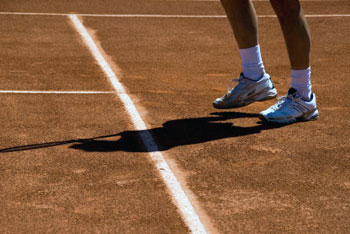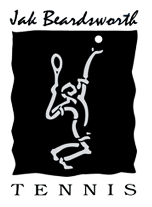JUNE/JULY 2011:
HARD COURTS, SOFT COURTS, and YOUR BODY’S ADAPTATION
Too often to not notice, I repeatedly experience a very curious impression that my top of the line footwear creates an even softer, more cushioned ride when playing on hard courts – which I rarely do - compared to when I’m playing on clay. What? Yet, I get the exact same sense when just walking from the parking lot to the clubhouse on the cement sidewalk. Subscribing to the conventional wisdom, how can that possibly be? Somehow I have to be misperceiving this.
 Perhaps not. Recent running studies, some products of small control groups, others based on biomechanical modeling, indicate that the human body, the most amazing self-righting machine, automatically adjusts to different surface hardness in order to keep the forces on the feet, ankles, knees, and hips as minimal as possible.
Perhaps not. Recent running studies, some products of small control groups, others based on biomechanical modeling, indicate that the human body, the most amazing self-righting machine, automatically adjusts to different surface hardness in order to keep the forces on the feet, ankles, knees, and hips as minimal as possible.
According to Dr. Stuart Warden, director of Translational Musculoskeletal Research at Indiana University, “If you run on a hard surface, your body decreases its stiffness. Your knees and hips flex more. On a soft surface, your legs stiffen.”
An example used by Warden compares the body’s auto-response when jumping off a table on to the floor, to landing on a trampoline. With the former you’d soften your knees at touchdown to better absorb the shock, which wouldn’t be necessary at all and, interestingly, not auto-employed in the latter dynamic with its practically cancelled out landing impact.
Playing well on clay, the “soft” surface, does require considerably more footwork. This takes form in stutter steps which become, even on a well groomed surface like the ones at the French Open, very necessary since an absolutely true bounce becomes the anomaly and not the norm that it always is on a hard court. The sheer number of foot plants is far greater – especially in close quarter doubles where more adjustment steps are needed in comparison to on-the-run singles – than on true bounce hard surfaces. .
In my last two on court seminar presentations to fellow professionals – one at the Stanford University indoor hard court facility, the other on the Tennis Hall of Fame’s indoor hard courts – I warmed-up for about :10 minutes as the attendees started arriving. To my amazement, in both instances, I dialed-in my groundies in no time at all – with an acute awareness of less physical stress than on the clay that I spend twelve months a year on – and found myself moving and striking balls with, for me, exceptional rhythm and relative ease.
Perhaps this repeating perception of mine is indeed a product of my body, smartly, softening-up its g-force foot strikes as needed. Conversely, is it possible that when I’m on soft surfaces – where the conventional wisdom does tell us, has always told us, that this is a more forgiving playing surface on the joints – my body becomes innately less attentive to absorbing foot strike shock?
Still, one might raise the question of braking from shot-to-shot, and its joint bearing consequences from surface to surface. Stopping on clay is far more forgiving in that you literally cannot stop on a dime, which you will absolutely be capable of on hard surfaces – unless you’re one of the modern day specimens who can actually slide on hard courts (are they using shoes with a different rubber compound?). The “dirt” will afford you a bit of slide-room, or more, depending on your foot speed to the ball and the condition of the court. Then again, timely movement into and out of the shot making moment can cancel-out the potential costs of “dime-stopping” on the hard stuff.
Ever notice, on congested roadways with numerous traffic lights, how some drivers race to the next red light only to jam on the brakes when they get there, while others accelerate and decelerate smoothly and efficiently, just as all good hard surface tennis movers do.
And consider how you instinctively utilized very light foot plants whenever you found yourself crossing the sun baked, red hot pavement adjacent to those childhood beaches and lakefronts barefoot . Speaking of barefoot, I would be remiss not to acknowledge the new running barefoot movement, and also the accompanying running minimalist footwear now being marketed that goes with it, ignited mostly by Christopher McDougall’s best selling book, Born To Run, about the Mexican outback Indian’s phenomenal endurance, injury free running deep in the totally isolated Copper Canyon outback completely without modern day “motion control” footwear.
 In any event, when you do find yourself on hard court surfaces, be conscious of maximizing your body’s apparent innate ability to cushion your ride. And, when on clay, avoid carelessly clunking around because you’re conditioned to thinking that you’re on a “soft” court and wearing $120 shoes and your bullet proof.
In any event, when you do find yourself on hard court surfaces, be conscious of maximizing your body’s apparent innate ability to cushion your ride. And, when on clay, avoid carelessly clunking around because you’re conditioned to thinking that you’re on a “soft” court and wearing $120 shoes and your bullet proof.
Finally, since I am on clay almost all the time, the outsoles of those expensive shoes take forever to wear out. The insoles, however, are a completely different matter. They wear out and lose their cushioning relatively quickly – about 40 hours for me. Yet, for the average player, it happens so incrementally it can sneak up on you, that is until you start hurting and you wonder why since your shoes are “only 3 months old.”
Currently, adidas provides the very best, well cushioned, longest lasting insoles in their tennis line, which are interchangeable among all brands. I typically wait for online sales of second tier models at Tennis Warehouse, and acquire a few pairs at a time just for the insoles, which I then rotate daily (currently 6 pr) in my K-Swiss Big Shots. When they are not in use they are placed in the sunlight to aerate them, and dry them out in high humidity environments, which helps refresh the all-important “inner” cushioning.
Improving your skill to move lightly and quickly on top of the court will contribute to achieving more viable hitting positions - on any surface – resulting in you not only performing at your very best but also contribute markedly to injury prevention and fatigue reduction.
Questions and comments are welcome at anytime for all tips present and past via email.
This Tip of the Month is copyright© by Jak Beardsworth Tennis. All rights reserved. Copies may be made only with the permission of and by Jak Beardsworth. Contact him here.
Tips Archive
- May, June, 2013 JUST TALKING HEADS OR MORE [read more]
- March, April, 2013 SELF-TALK: Good, Bad, or Indifferent [read more]
- January, February, 2013 BOOK-A-MILLION: Do Tennis Players Read? [read more]
- December, 2012 THE KEY TO TOUR LEVEL BALL STRIKING: And How to Learn It [read more]
- November, 2012 ARE YOU A THUDDER, A TWANGER, OR A PINGER: Racket Dampeners [read more]
- September, October, 2012 SMART SHOTS [read more]
- July, August, 2012 TEN TOP STRESS REDUCERS [read more]
- June, 2012 MAKING YOUR LESSONS STICK [read more]
- May, 2012 THE IMPOSSIBLE: Accelerating and Decelerating Simultaneously [read more]
- April, 2012 PLAYER DISCONNECTION [read more]
- March, 2012 BENDING THE SERVE IN [read more]
- February, 2012 UNDERSTANDING TERMINOLOGY: Drill vs Clinic vs Team Practice [read more]
- January, 2012 PLAYING SCARED? [read more]
- December, 2011 CUTTING OFF THE ANGLE…VERTICALLY [read more]
- November, 2011 WHY COACHING? [read more]
- October, 2011 THE EASY BALLS ARE NOT EASY [read more]
- August/September, 2011 NEVER TOO LATE FOR OLDER DOGS [read more]
- June/July, 2011 HARD COURTS, SOFT COURTS, and YOUR BODY'S ADAPTATION [read more]
- April/May, 2011 JAW DROPPNG [read more]
- March, 2011 CLUB DOUBLES' INCREASINGLY MISSING LINK [read more]
- February, 2011 TIP 2 | POOH POOHING DOUBLES STRATEGY SESSIONS [read more]
- February, 2011 TIP 1 | CLAY TO HARD, HARD TO CLAY [read more]
- January, 2011 ICING THE SERVER WHEN RECEIVING IN THE BIG MOMENTS [read more]
- December, 2010 JOHN ISNER’S “GOOD MISS” [read more]
- November, 2010 THE MOST NEGLECTED SHOT IN THE GAME [read more]
- October, 2010 BALL BOUNCING and the SERVE [read more]
- September, 2010 TAKE YOUR EYE OFF THE BALL [read more]
- July-August, 2010 SUMMER SCHOOL COURTSIDE CRIB SHEET [read more]
- May-June, 2010 THE 2-HANDED JUMP BACKHAND: The Dumbest Shot in Tennis [read more]
- April, 2010 THE STANDING AROUND SYNDROME [read more]
- March, 2010 THE ELUSIVE SERVICE TOSS [read more]
- February, 2010 PREPARING TO START THE POINT: Serving and Receiving [read more]
- January, 2010 DEBUNKING THE MODERN GAME [read more]
- December, 2009 RELAX – IT'S JUST A RALLY BALL [read more]
- November, 2009 DEFEATING THE POACHER [read more]
- October, 2009 PRACTICE, PRACTICE, PRACTICE [read more]
- September, 2009 SERVING SUCCESS: Warming-Up vs Match Play [read more]
- August, 2009 THE SPLIT STEP: Defending the Court, Rushing the Net, and More [read more]
- July, 2009 THE THIRD GROUNDSTROKE [read more]
- June, 2009 HOW MANY HANDS DOES IT TAKE? [read more]
- May, 2009 THE MOST IMPORTANT SKILL [read more]
- April, 2009 PLAYING IN THE FLORIDA WIND [read more]
- March, 2009 Letting them Play for Peak Performance in Clubland [read more]
- February, 2009 SUPPORTING YOUR GAME [read more]
- January, 2009 RESPECTING THE GAME: Top 10 Do's & Don'ts [read more]
- December, 2008 Getting the Warm-up Right [read more]
- November, 2008 Visualize...Realize: The Mind Body Connection [read more]
- October, 2008 Reading Their Mail [read more]


